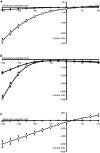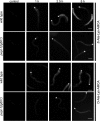Peptide transporter isoforms are discriminated by the fluorophore-conjugated dipeptides β-Ala- and d-Ala-Lys-N-7-amino-4-methylcoumarin-3-acetic acid
- PMID: 24744852
- PMCID: PMC3970736
- DOI: 10.1002/phy2.165
Peptide transporter isoforms are discriminated by the fluorophore-conjugated dipeptides β-Ala- and d-Ala-Lys-N-7-amino-4-methylcoumarin-3-acetic acid
Abstract
Peptide transporters of the SLC15 family are classified by structure and function into PEPT1 (low-affinity/high-capacity) and PEPT2 (high-affinity/low-capacity) isoforms. Despite the differences in kinetics, both transporter isoforms are reckoned to transport essentially all possible di- and tripeptides. We here report that the fluorophore-conjugated dipeptide derivatives β-Ala-Lys-N-7-amino-4-methylcoumarin-3-acetic acid (β-AK-AMCA) and d-Ala-Lys-N-7-amino-4-methylcoumarin-3-acetic acid (d-AK-AMCA) are transported by distinct PEPT isoforms in a species-specific manner. Transport of the fluorophore peptides was studied (1) in vitro after heterologous expression in Xenopus oocytes of PEPT1 and PEPT2 isoforms from different vertebrate species and of PEPT1 and PEPT2 transporters from Caenorhabditis elegans by using electrophysiological and fluorescence methods and (2) in vivo in C. elegans by using fluorescence methods. Our results indicate that both substrates are transported by the vertebrate "renal-type" and the C. elegans "intestinal-type" peptide transporter only. A systematic analysis among species finds four predicted amino acid residues along the sequence that may account for the substrate uptake differences observed between the vertebrate PEPT1/nematode PEPT2 and the vertebrate PEPT2/nematode PEPT1 subtype. This selectivity on basis of isoforms and species may be helpful in better defining the structure-function determinants of the proteins of the SLC15 family.
Keywords: Caenorhabditis elegans; PEPT1; PEPT2; di‐ and tripeptide; substrate specificity; transporter.
Figures





Similar articles
-
A new use of β-Ala-Lys (AMCA) as a transport reporter for PEPT1 and PEPT2 in renal brush border membrane vesicles from the outer cortex and outer medulla.Biochim Biophys Acta Biomembr. 2018 May;1860(5):960-964. doi: 10.1016/j.bbamem.2017.12.021. Epub 2017 Dec 30. Biochim Biophys Acta Biomembr. 2018. PMID: 29291378
-
Structural requirements for determining the substrate affinity of peptide transporters PEPT1 and PEPT2.Pflugers Arch. 2000 Sep;440(5):679-84. doi: 10.1007/s004240000339. Pflugers Arch. 2000. PMID: 11007306
-
Stoichiometry and kinetics of the high-affinity H+-coupled peptide transporter PepT2.J Biol Chem. 1999 Jan 29;274(5):2773-9. doi: 10.1074/jbc.274.5.2773. J Biol Chem. 1999. PMID: 9915809
-
The proton oligopeptide cotransporter family SLC15 in physiology and pharmacology.Pflugers Arch. 2004 Feb;447(5):610-8. doi: 10.1007/s00424-003-1101-4. Epub 2003 Aug 7. Pflugers Arch. 2004. PMID: 12905028 Review.
-
Physiological and pharmacological implications of peptide transporters, PEPT1 and PEPT2.Nephrol Dial Transplant. 2000;15 Suppl 6:11-3. doi: 10.1093/ndt/15.suppl_6.11. Nephrol Dial Transplant. 2000. PMID: 11143972 Review.
Cited by
-
The peptide transporter 1a of the zebrafish Danio rerio, an emerging model in nutrigenomics and nutrition research: molecular characterization, functional properties, and expression analysis.Genes Nutr. 2019 Dec 19;14:33. doi: 10.1186/s12263-019-0657-3. eCollection 2019. Genes Nutr. 2019. PMID: 31890051 Free PMC article.
-
Salt Bridge Swapping in the EXXERFXYY Motif of Proton-coupled Oligopeptide Transporters.J Biol Chem. 2015 Dec 11;290(50):29931-40. doi: 10.1074/jbc.M115.675603. Epub 2015 Oct 19. J Biol Chem. 2015. PMID: 26483552 Free PMC article.
-
Kinetic Measurements of Di- and Tripeptide and Peptidomimetic Drug Transport in Different Kidney Regions Using the Fluorescent Membrane Potential-Sensitive Dye, DiS-C3-(3).J Membr Biol. 2017 Dec;250(6):641-649. doi: 10.1007/s00232-017-9990-x. Epub 2017 Oct 7. J Membr Biol. 2017. PMID: 28988287
-
Di- and tripeptide transport in vertebrates: the contribution of teleost fish models.J Comp Physiol B. 2017 Apr;187(3):395-462. doi: 10.1007/s00360-016-1044-7. Epub 2016 Nov 1. J Comp Physiol B. 2017. PMID: 27803975 Review.
-
Organoids to Study Intestinal Nutrient Transport, Drug Uptake and Metabolism - Update to the Human Model and Expansion of Applications.Front Bioeng Biotechnol. 2020 Sep 11;8:577656. doi: 10.3389/fbioe.2020.577656. eCollection 2020. Front Bioeng Biotechnol. 2020. PMID: 33015026 Free PMC article.
References
-
- Abe H., Satoh M., Miyauchi S., Shuto S., Matsuda A., Kamo N. 1999. Conjugation of dipeptide to fluorescent dyes enhances its affinity for a dipeptide transporter (PEPT1) in human intestinal Caco‐2 cells. Bioconjug. Chem.; 10:24-31 - PubMed
-
- Bednarczyk D., Mash E. A., Aavula B. R., Wright S. H. 2000. NBD‐TMA: a novel fluorescent substrate of the peritubular organic cation transporter of renal proximal tubules. Pflugers Arch.; 440:184-192 - PubMed
-
- Biegel A., Gebauer S., Hartrodt B., Brandsch M., Neubert K., Thondorf I. 2005. Three‐dimensional quantitative structure‐activity relationship analyses of beta‐lactam antibiotics and tripeptides as substrates of the mammalian H+/peptide cotransporter PEPT1. J. Med. Chem.; 48:4410-4419 - PubMed
-
- Biegel A., Gebauer S., Brandsch M., Neubert K., Thondorf I. 2006. Structural requirements for the substrates of the H+/peptide cotransporter PEPT2 determined by three‐dimensional quantitative structure‐activity relationship analysis. J. Med. Chem.; 49:4286-4296 - PubMed
LinkOut - more resources
Full Text Sources
Other Literature Sources
Molecular Biology Databases

